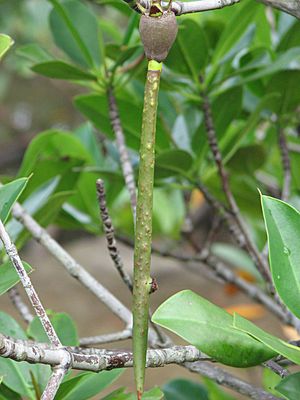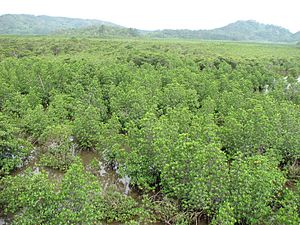Loop-root mangrove facts for kids
Quick facts for kids Loop-root mangrove |
|
|---|---|
 |
|
| Rhizophora mucronata with propagule | |
| Conservation status | |
| Scientific classification | |
| Genus: |
Rhizophora
|
| Species: |
mucronata
|
| Synonyms | |
|
|
The loop-root mangrove (also known as the red mangrove or Asiatic mangrove) is a special type of tree called a mangrove. You can find it growing along coastlines and river banks in places like East Africa and the Indo-Pacific region.
Contents
Meet the Red Mangrove
The red mangrove is an evergreen tree. This means it stays green all year round. It can grow to be about 20 to 25 meters (65 to 82 feet) tall when it's by rivers. If it's closer to the sea, it's usually a bit shorter, around 10 to 15 meters (33 to 49 feet) tall. The tallest trees grow closest to the water.
This tree has many special "stilt roots" that grow from its trunk and branches. These roots look like stilts and help support the tree in the soft mud. The leaves are shaped like an oval. They are usually about 12 centimeters (5 inches) long and 6 centimeters (2.4 inches) wide. The tips of the leaves are long, but they often break off. The underside of the leaves is pale and has bumpy, cork-like spots.
The flowers grow in groups on the twigs. Each flower has a hard, cream-colored outer part called a calyx with four sepals. Inside, there are four white, fuzzy petals.
One cool thing about these trees is how their seeds grow. The seeds start to grow while they are still attached to the tree! This is called viviparous growth. The root of the seed gets very long, sometimes over a meter (3 feet) long. Once the seed, called a propagule, is big enough, it drops off the branch. Then it can root itself in the mud below and start a new tree.
Where Do They Live?
You can find the red mangrove in the Indo-Pacific region. This includes river banks and coastal areas. It's the only mangrove species found in East Africa.
It grows naturally in many parts of the world:
- Africa: Southeastern Egypt, eastern Ethiopia, eastern Kenya, Madagascar, Mauritius, Mozambique, the Seychelles, Somalia, eastern South Africa, southeastern Sudan, and eastern Tanzania.
- Asia: Myanmar, Cambodia, India, Pakistan, Iran, Indonesia, the Ryukyu Islands of Japan, Malaysia, Papua New Guinea, the Philippines, Sri Lanka, Taiwan, Thailand, and Vietnam.
- South Pacific: The Solomon Islands and Vanuatu.
- Australia: Northern Northern Territory and northern Queensland.
The red mangrove's favorite places to live are estuaries (where rivers meet the sea), tidal creeks, and flat coastal areas. These places get flooded by the tide every day. This tree can handle more flooding than other mangrove species. It often forms a green border around mangrove forests. Sometimes, it grows by itself, or it might grow with another mangrove called Rhizophora apiculata. In South Africa, the red mangrove is a protected tree.
Who Lives Around Them?
The red mangrove can easily grow from its seeds. However, young seedlings are sometimes harmed by crabs. Crabs also like to eat the leaves of the red mangrove. These leaves are also a food source for the crab-eating macaque, a type of monkey. A beetle called Poecilus fallax can also attack the tree.
In the Mangalavanam Bird Sanctuary in India, the red mangrove grows alongside other plants. These include the mangrove Avicennia officinalis, the golden leather fern, and the sea holly.
How Do People Use Them?
The red mangrove is a very useful tree!
- It helps protect coastlines from erosion (when land is worn away by water).
- It is used to help bring back mangrove habitats that have been damaged.
- The wood from the tree is used for firewood.
- People use its timber to build things like houses, poles, and even fish traps.
- The fruits of the red mangrove can be cooked and eaten. You can also get juice from them to make wine.
- The young shoots can be eaten as a vegetable.
- The bark is used in tanning, which is a process to make leather.
- A dye can be made from both the bark and the leaves.
- Different parts of the plant are also used in traditional medicine.
Images for kids





